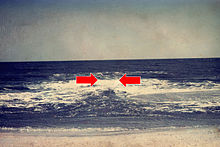Surf zone
This article has multiple issues. Please help improve it or discuss these issues on the talk page. (Learn how and when to remove these messages)
|

The surf zone or breaker zone is the nearshore part of a body of open water between the line at which the waves break and the shore. As ocean surface waves approach a shore, they interact with the bottom, get taller and steeper, and break, forming the foamy surface called surf. The region of breaking waves defines the surf zone. After breaking in the surf zone, the waves (now reduced in height) continue to move in, and they run up onto the sloping front of the beach, forming an uprush of water called swash. The water then runs back again as backwash. The water in the surf zone is relatively shallow, depending on the height and period of the waves.
Animal life
[edit]The animals that often are found living in the surf zone are crabs, clams, and snails. Surf clams and mole crabs are two species that stand out as inhabitants of the surf zone. Both of these animals are very fast burrowers. The surf clam, also known as the variable coquina, is a filter feeder that uses its gills to filter microalgae, tiny zooplankton, and small particulates out of seawater. The mole crab is a suspension feeder that eats by capturing zooplankton with its antennae. All of these creatures burrow down into the sand to escape from being pulled into the ocean from the tides and waves. They also burrow themselves in the sand to protect themselves from predators. The surf zone is full of nutrients, oxygen, and sunlight which leaves the zone very productive with animal life.
Rip currents
[edit]
The surf zone can contain dangerous rip currents: strong local currents which flow offshore and pose a threat to swimmers. Rip-current outlooks use the following set of qualifications:
- Low-risk rip currents: Wind and/or wave conditions are not expected to support the development of rip currents; however, rip currents can sometimes occur, especially in the vicinity of jetties and piers. Know how to swim and heed the advice of lifeguards.
- Moderate-risk rip currents: Wind and/or wave conditions support stronger or more frequent rip currents. Only experienced surf swimmers should enter the water.
- High-risk rip currents: Wind and/or wave conditions support dangerous rip currents. Rip currents are life-threatening to anyone entering the surf.
See also
[edit]References
[edit]- Pinet, Paul R (2008) Invitation to Oceanography, Chapter 11: The Dynamic Shoreline. Edition 5 revised. Jones & Bartlett Learning, ISBN 0-7637-5993-7
- "Breaker Zone." The Free Dictionary. Farlex Inc, 2012. Web. 18 Apr. 2012. <http://www.thefreedictionary.com/breaker+zone>.
External links
[edit]- MetEd (2012) Rip currents: Nearshore fundamentals University Corporation for Atmospheric Research. Retrieved 17 April 2012.




